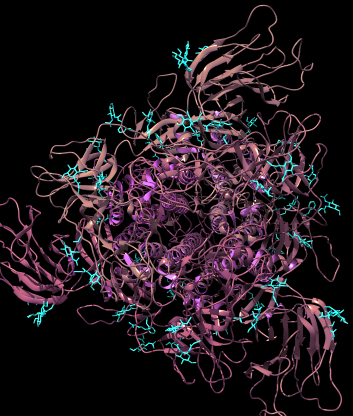 ow hard would it be to create a virus designed to cause paralysis and
cognitive impairment? What if we just tossed in a few extra
furin cleavage sites to existing viruses to see what would happen?
Believe it or not, scientists have tried it.
ow hard would it be to create a virus designed to cause paralysis and
cognitive impairment? What if we just tossed in a few extra
furin cleavage sites to existing viruses to see what would happen?
Believe it or not, scientists have tried it.
In a little-noticed 2021 paper,[1] virologists at China Agricultural University in Beijing mutated infectious bronchitis virus (IBV), an avian coronavirus that affects chickens but not humans, to introduce an extra furin-s2′ cleavage site. IBV already contains one furin cleavage site; this new one in IBV is within the S2 subunit itself, giving it a total of two.
As is widely known, SARS-CoV-2 contains a furin cleavage site between the S1 and S2 subunits. Cleavage causes the S1 and S2 subunits to separate, which is required for pathogenesis. Since furin is abundant in many different cells, adding a furin cleavage site allows the virus to attack cells that would normally be resistant. It therefore changes the organ specificity, or tropism, of the virus. As in SARS-CoV-2, the S1 subunit in IBV contains a receptor binding domain, while S2 contains a fusion peptide and a transmembrane domain needed for the virus to enter a cell.
To create the new furin site, the researchers replaced the original sequence of PRGR↓S in IBV with RRKR↓S (where '↓' indicates where the cleavage occurs) in the S2 subunit of the spike protein but left the S1 subunit unchanged. The researchers called the mutant rYN-S2/RRKR.
Just as happened with SARS-CoV-2, adding a new furin cleavage site dramatically changed the tropism of IBV. Instead of infecting the trachea, rYN-S2/RRKR infected neuronal cells and monocytes (a type of white blood cell) and showed increased pathogenicity. The mutated virus also showed increased blood-brain barrier (BBB) permeability compared to the wild-type virus, which means it could reach the brain more easily.

Top view of IBV shows a trimeric structure typical of coronavirus spike proteins. Data source: [2]. Rendered in Chimera
When injected into the bloodstream of chickens, rYN-S2/RRKR caused severe encephalitis with clear neurologic symptoms, followed by paralysis and death of 80% of the animals. This didn't happen with the un-mutated (wild-type) virus.
The authors could not establish precisely how rYN-S2/RRKR got into the brain, but they hypothesized that TNF-α might be responsible. TNF-α is a cytokine, a small protein secreted by immune cells that causes breakdown of the BBB and induces death in infected cells.
The authors showed that brain access was not caused by retrograde transport through peripheral nerves, as occurs with rabiesvirus and herpesviruses, but through the BBB. They showed clear immunohistochemical images and electron microscope photos demonstrating the presence of rYN-S2/RRKR in brain neurons. It is nice work and it shows how a simple genetic manipulation can dramatically change the tropism of respiratory viruses, turning them into viruses that cause severe brain injury.
Discussion
There are significant differences between mutated IBV and SARS-CoV-2, the most important one being that IBV does not affect humans. The concern is not about IBV itself but what would happen if a human coronavirus should somehow acquire a similar mutation and cause a viral encephalitis pandemic.
For serious human pathogens, researchers typically use replication-incompetent viruses and take elaborate precautions to avoid exposure. But endemic pathogens that only affect animals are typically done under much less stringent safety conditions. Often the animal protocol is vague about how animal bedding and lab waste is treated. It's easy to imagine how a virus or bacterium that affects only animals could make its way to a landfill or go into the sewage system.
Then someday a mysterious new disease shows up in wild birds or maybe rabbits or bats. Some big virology lab “discovers” it and decides to study whether it could be a zoonotic infection (an animal disease that affects humans), so they culture it in humanized cells and transgenic animals with human enzymes, just to see what would happen. Next thing you know, there's a new airborne disease that causes paralysis and permanent cognitive impairment in humans. Funding agencies and scientific journals circle the wagons and call anyone who questions it a racist conspiracy theorist.
You don't need a malevolent conspiracy. All you need is those six magic words: “just to see what will happen” without thinking it through. Systems failure does the rest.
[1] Cheng J, Zhao Y, Hu Y, Zhao J, Xue J, Zhang G. The furin-S2' site in avian coronavirus plays a key role in central nervous system damage progression. J Virol. 2021 May 10;95(11):e02447-20. doi: 10.1128/JVI.02447-20. PMID: 33727330; PMCID: PMC8139701.
[2] Cryo-electron microscopy structure of infectious bronchitis coronavirus spike protein Shang J, Zheng Y, Yang Y, Liu C, Geng Q, Luo C, Zhang W, Li F. (2018) PLoS Pathog 14: e1007009-e1007009.
dec 20 2023, 3:27 am. edited for brevity dec 21 2023
